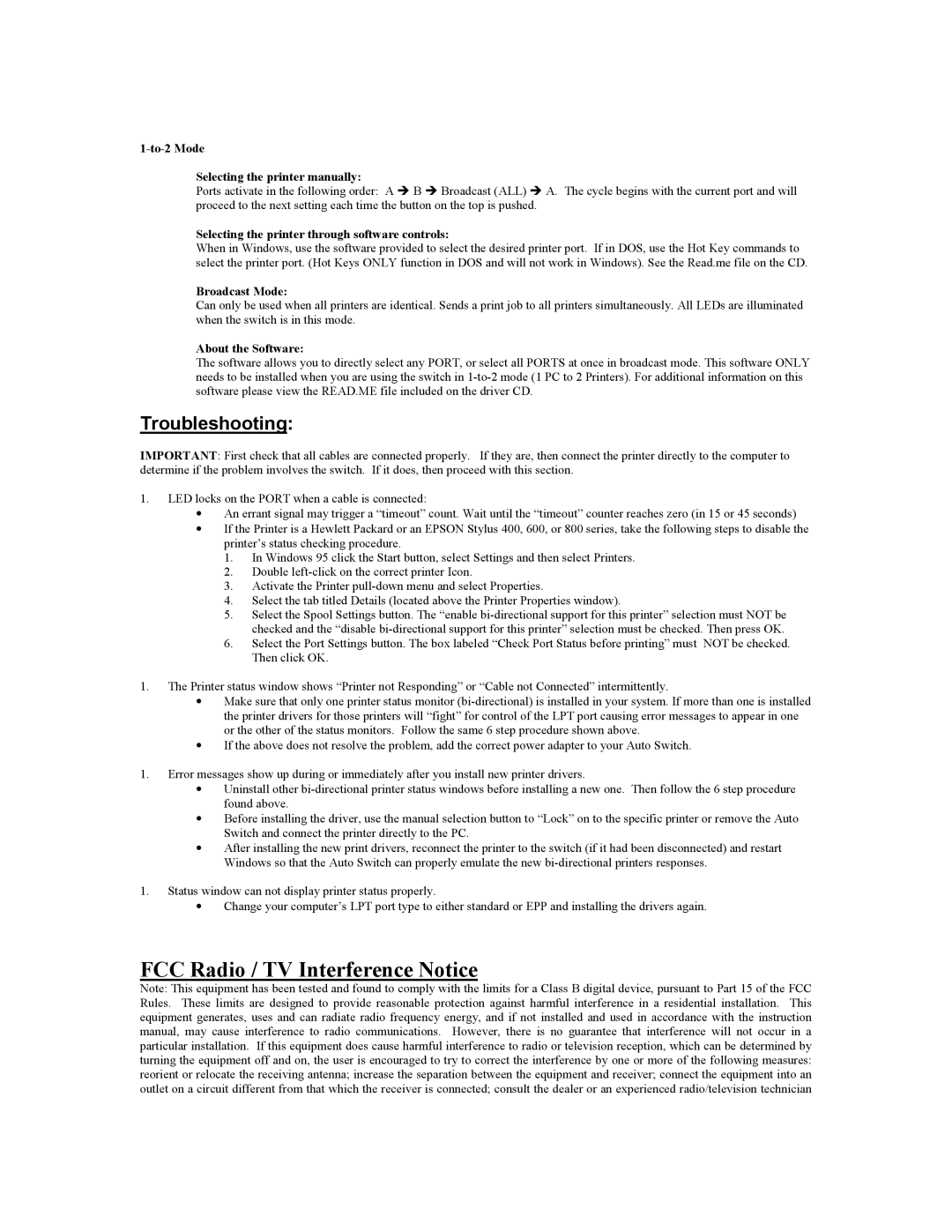1-to-2 Mode
Selecting the printer manually:
Ports activate in the following order: A Î B Î Broadcast (ALL) Î A. The cycle begins with the current port and will proceed to the next setting each time the button on the top is pushed.
Selecting the printer through software controls:
When in Windows, use the software provided to select the desired printer port. If in DOS, use the Hot Key commands to select the printer port. (Hot Keys ONLY function in DOS and will not work in Windows). See the Read.me file on the CD.
Broadcast Mode:
Can only be used when all printers are identical. Sends a print job to all printers simultaneously. All LEDs are illuminated when the switch is in this mode.
About the Software:
The software allows you to directly select any PORT, or select all PORTS at once in broadcast mode. This software ONLY needs to be installed when you are using the switch in
Troubleshooting:
IMPORTANT: First check that all cables are connected properly. If they are, then connect the printer directly to the computer to determine if the problem involves the switch. If it does, then proceed with this section.
1.LED locks on the PORT when a cable is connected:
•An errant signal may trigger a “timeout” count. Wait until the “timeout” counter reaches zero (in 15 or 45 seconds)
•If the Printer is a Hewlett Packard or an EPSON Stylus 400, 600, or 800 series, take the following steps to disable the printer’s status checking procedure.
1.In Windows 95 click the Start button, select Settings and then select Printers.
2.Double
3.Activate the Printer
4.Select the tab titled Details (located above the Printer Properties window).
5.Select the Spool Settings button. The “enable
6.Select the Port Settings button. The box labeled “Check Port Status before printing” must NOT be checked. Then click OK.
1.The Printer status window shows “Printer not Responding” or “Cable not Connected” intermittently.
•Make sure that only one printer status monitor
•If the above does not resolve the problem, add the correct power adapter to your Auto Switch.
1.Error messages show up during or immediately after you install new printer drivers.
•Uninstall other
•Before installing the driver, use the manual selection button to “Lock” on to the specific printer or remove the Auto Switch and connect the printer directly to the PC.
•After installing the new print drivers, reconnect the printer to the switch (if it had been disconnected) and restart Windows so that the Auto Switch can properly emulate the new
1.Status window can not display printer status properly.
•Change your computer’s LPT port type to either standard or EPP and installing the drivers again.
FCC Radio / TV Interference Notice
Note: This equipment has been tested and found to comply with the limits for a Class B digital device, pursuant to Part 15 of the FCC Rules. These limits are designed to provide reasonable protection against harmful interference in a residential installation. This equipment generates, uses and can radiate radio frequency energy, and if not installed and used in accordance with the instruction manual, may cause interference to radio communications. However, there is no guarantee that interference will not occur in a particular installation. If this equipment does cause harmful interference to radio or television reception, which can be determined by turning the equipment off and on, the user is encouraged to try to correct the interference by one or more of the following measures: reorient or relocate the receiving antenna; increase the separation between the equipment and receiver; connect the equipment into an outlet on a circuit different from that which the receiver is connected; consult the dealer or an experienced radio/television technician
